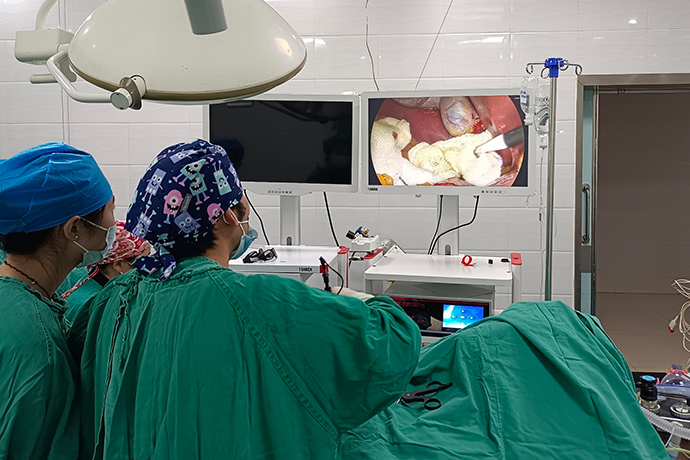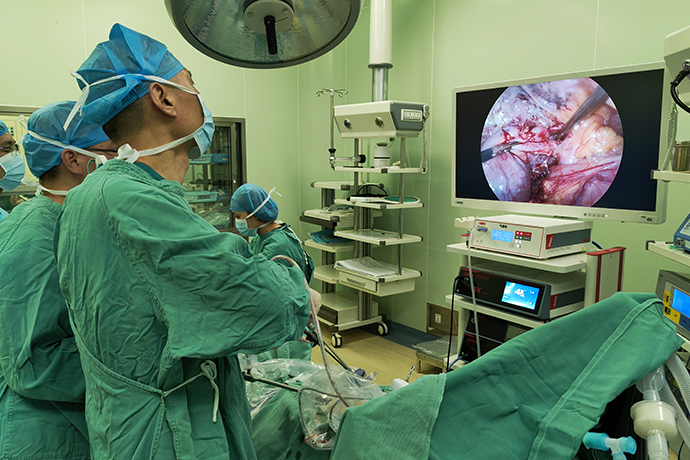【Laparoscopy in Gallbladder Surgery】Cholecystectomy
Release time: 22 Nov 2022 Author:Shrek
With the continuous development and improvement of laparoscopic technology, the technology of laparoscopic cholecystectomy is becoming more and more mature, and the scope of indications is expanding. Many cases that were originally considered contraindications or relative contraindications have now been included in the scope of surgical indications. More and more surgeons have accepted this new surgical approach, and laparoscopic cholecystectomy has become the gold standard for the treatment of benign gallbladder diseases.

Indications
Laparoscopic cholecystectomy is indicated for all gallbladder diseases for which surgery is not contraindicated:
1.Gallstones.
2.Gallbladder inflammation:①Acute cholecystitis with or without stones;②Chronic cholecystitis.
3.Gallbladder tumors:①gallbladder polypoid lesions or gallbladder protruding lesions;② gallbladder adenoma; ③gallbladder cancer Nevin stage I and UICC stage I lesions.
Preoperative
Preoperative talk
Introduce the characteristics and limitations of this operation to the patient and their family members, and the possibility of converting to laparotomy during the operation, and explain the risks and possible complications of laparoscopic surgery to the family members, and ask the family members to sign.
Preoperative preparation
1.Routine preparation: ①Preoperative blood, urine, feces routine examination, liver, gallbladder, and pancreas B-ultrasound, electrocardiogram, X-ray chest X-ray, liver and kidney function, coagulation function, blood electrolytes, etc, CT examination of the upper abdomen when tumors are suspected (Plain scan + enhanced) ②Assess and treat systemic medical diseases ③Fast and drink on the morning of surgery, and clean the navel.
2.Instrument preparation: special laparoscopic instrument preparation.
Anesthesia and Positioning
General anesthesia with endotracheal intubation. Take the supine position, the head is high and the feet are low 20°~30°, and the operating table is tilted 20°~30°to the left.
Surgical procedure
The four-hole method is usually adopted: a 10mm incision is made at the umbilicus as the observation hole, a 10mm incision is made 2cm below the xiphoid process to the right as the main operation hole, 2 cm below the costal margin of the right midclavicular line, and two 5mm incisions of 5mm below the costal margin of the right anterior axillary line are used as auxiliary operations hole. There are also those who do the three-hole method.
1.Make the first incision in the umbilicus to insert the cannula and put the camera.
2.Make the remaining three incisions in the upper abdomen and insert the cannula.
3.Find the gallbladder and grab it with clamps.
4.Peel off the fat to reveal two important structures, the cystic duct and the cystic artery.
5.Clamp the cystic duct and cystic artery and cut.
6.Begin peeling the gallbladder away from the back of the liver.
7.Move gently until the gallbladder is completely peeled off.
8.Put the gallbladder into this small bag and take it out through the incision in the upper abdomen.
9.Finally, let’s see what gallstones look like.
Precautions
1.Intraoperative bleeding
①Electrocoagulation treatment, suitable for bleeding of small non-important structures and hemorrhage of the gallbladder bed of the liver
②Clamping treatment, suitable for the position of the bleeding point is clear and can be clamped with separating forceps
③Suture ligation is suitable for bleeding on the surface of important structures that are not suitable for clamping. This operation requires skilled technology and tacit cooperation
④In case of massive bleeding, laparotomy should be performed if necessary.
2. Bile duct injury
90% of bile duct injuries occur in cholecystectomy, which is a serious complication of bile duct surgery. Injury is divided into partial bile duct wall injury, bile duct transection, bile duct transection and ligation. The most common site of injury is the confluence of the cystic duct, common hepatic duct, and common bile duct. The main reasons for the occurrence are anatomical disorder caused by bile duct variation, inflammation, adhesion, and scar formation in the trigone of the gallbladder, as well as the operator's overconfidence, rough operation, or inexperience, especially when the cystic artery is bleeding and hemostasis is more likely to occur with forceps. Once bile duct injury is found, it is usually converted to laparotomy. In case of small injury or the surgeon has rich experience and skilled laparoscopic techniques, it can also be attempted to be completed under laparoscopy.
Treatment: ①Injury to the vagus bile duct in the gallbladder bed of the liver should be closed by electric coagulation, clamped or sutured, but it must be confirmed that it is not a mutated right hepatic duct.
②Bile duct wall electrical burns were sutured with 4-0 or 5-0 absorbable suture, and a drainage tube was placed.
③Bile duct damage less than 2/3 of the diameter of the bile duct is sutured with intermittent absorbable suture, and a built-in "T"-shaped tube supports drainage and leads from the healthy bile duct.
④When the bile duct injury is greater than 2/3 of the diameter of the bile duct, if the blood supply to the injury is good and there is no obvious tension, it can be sutured with intermittent absorbable sutures, and a built-in "T"-shaped tube supports drainage; if the blood supply is poor and the tension is large, go far Closure of terminal bile duct, Roux-en-Y anastomosis of proximal bile duct and jejunum.
⑤If no injury is found during the operation, and biliary peritonitis caused by bile leakage is found after the operation, another operation should be performed immediately.
⑥If jaundice is found after operation and the possibility of bile duct injury is suspected, necessary examinations should be carried out, such as B-ultrasound, MRCP, ERCP, etc. to confirm the diagnosis, and then carry out corresponding treatment.
Types of bile duct injury
Injuries to adjacent organs may be caused by adhesions around the gallbladder or rough manipulations, such as the stomach, duodenum, and transverse colon. If it is found during the operation, it should be sutured and repaired immediately; if a gastric or intestinal fistula is found after the operation, it should be repaired again. For beginners, it is necessary to re-explore the abdominal cavity at the end of the operation.
Laparoscopic Cholecystectomy FAQs
One: Why do patients with cholecystitis, gallstones and polyps need to have their gallbladder removed?
1.Symptoms such as pain caused by inflammation and stones affect daily life.
2.Empyema or rupture may occur during acute inflammation, causing greater damage to the body and even threatening life.
3.Small gallstones in the gallbladder have the risk of falling into the common bile duct, leading to common bile duct stones, causing acute cholangitis or biliary pancreatitis, the risk of surgery will increase, and the hospital stay will be prolonged.
4.Long-term stimulation of gallbladder polyps or stones may cause gallbladder cancer in some people.
Two: In those cases, laparoscopic cholecystectomy cannot be used?
1.Obstructive jaundice, extrahepatic bile duct stones or biliary stricture.
2.Gallbladder cancer, or highly suspected cancer.
3.Liver cirrhosis and portal hypertension.
4.Middle and late pregnancy.
5.Abdominal infection, peritonitis.
6.Associated with bleeding disorders and coagulation disorders.
7.Severe cardiopulmonary dysfunction and those who cannot tolerate general anesthesia.
8.Patients with cholangioenteric fistula and extensive and severe adhesions in the abdominal cavity are not suitable for establishing artificial pneumoperitoneum.
Three: Is there any impact on health after gallbladder removal?
1.The gallbladder is only a storage organ of the biliary system, which stores and concentrates the bile secreted by the liver.
2.Bile is secreted by the liver, and bile helps digest fatty foods.
3.After suffering from gallstones and cholecystitis, the gallbladder reduces or loses these functions.
4.In the early stage of cholecystectomy, about 1% of cholecystectomy patients may have short-term effects on fat digestion due to low bile concentration, and steatorrhea may occur after eating a high-fat diet. However, as time goes by, the common bile duct will gradually expand and gradually replace the gallbladder's function of storing and concentrating bile. In about half a year, intestinal fat digestion returns to normal, and steatorrhea will no longer occur.
Four: Will the risk of colon cancer increase after cholecystectomy?
1.The increased incidence of colon cancer in patients with gallbladder stones is a common phenomenon observed. There is no correlation between the two, and it has not been confirmed by scientific evidence so far.
2.Patients with gallbladder stones have an increased risk of colon cancer due to the action of lithogenic bile, not cholecystectomy itself.
3.It is an objective fact that cholecystectomy can eliminate the symptoms of patients and the complications of gallbladder stones after more than 100 years of practice. Laparoscopic cholecystectomy has become the gold standard for the treatment of gallstones in the gallbladder.
Five: Can gallbladder stones be removed through laparoscopic surgery?
1. LC has a larger field of view than traditional laparotomy, and the operation is faster
2.The basic process of LC and traditional laparotomy is basically the same. Dissect the structure of the gallbladder triangle, clamp and cut off the cystic duct and cystic artery, and then remove the entire gallbladder including stones.
3.It can be seen that the effect of LC and traditional open cholecystectomy is the same.
Six: Does cholecystectomy lead to long stones in the bile duct?
1.The components of gallbladder stones and bile duct stones are different. Gallbladder stones are mostly cholesterol stones, while bile duct stones are mostly pigment stones.
2.The pathogenesis of gallbladder stones and bile duct stones is different.
3.There are millions of cases of cholecystectomy in the world every year, and after long-term clinical observation, no increase in bile duct stones in patients after cholecystectomy has been found.
Seven: How many days does LC surgery need to be hospitalized?
1.Generally, it takes 2-3 days. The preoperative examination is completed within 1-2 days after admission, and most patients can be discharged from the hospital on the second or third day after the operation.
2.Now our hospital implements the LC day surgery mode, the preoperative examination for suitable patients is completed before hospitalization, surgery is performed on the day of admission, and the patient is discharged the next day.
Eight: What should be paid attention to in terms of diet and activities after discharge from the hospital?
There are no special taboos on food varieties, and the food taboos considered by the people have no scientific basis.
The amount of food should follow the principle of "step by step", with comfort as the standard, and avoid "tonic", but you can't just eat food with incomplete nutrients such as porridge.
There are no clear restrictions on activities, and the principle is to do what we can, and we can usually resume normal work within a week.
Nine: When do you take a bath after leaving the hospital?
1.Generally speaking, you can take a shower 48 hours after the stitches are removed.
2.Do not directly touch the wound when washing. Use a dry towel to dry the wound and avoid rubbing, especially avoid rubbing perpendicular to the direction of the wound to prevent the wound from dehiscence.
3.Some patients are really worried, and they can use a waterproof band-aid to cover the incision tightly and take a bath.
Ten: Do I need to come to the hospital for follow-up consultation after discharge?
1.Generally not needed.
2.The stitches can be removed 7-10 days after the operation, which can be done in the hospital or in the nearest hospital.
3.If the following situations occur, please return to the hospital for treatment immediately:
(1) Incision local pain, increased redness and swelling.
(2) Odor-smelling discharge from the incision.
(3) Abdominal pain, accompanied by nausea and vomiting.
(4) Chills or fever.
(5) Yellow urine or whites of eyes, yellow skin.

- Recommended news
- 【General Surgery Laparoscopy】Cholecystectomy
- Surgery Steps of Hysteroscopy for Intrauterine Adhesion
- [Gynecological Hysteroscopy] Techniques for Preventing and Treating Complications of Hysteroscopic Surgery
- [Gynecological Hysteroscopy] Hysteroscopic Adhesiolysis
- [Gynecological Hysteroscopy] IUD Removal under Hysteroscopy